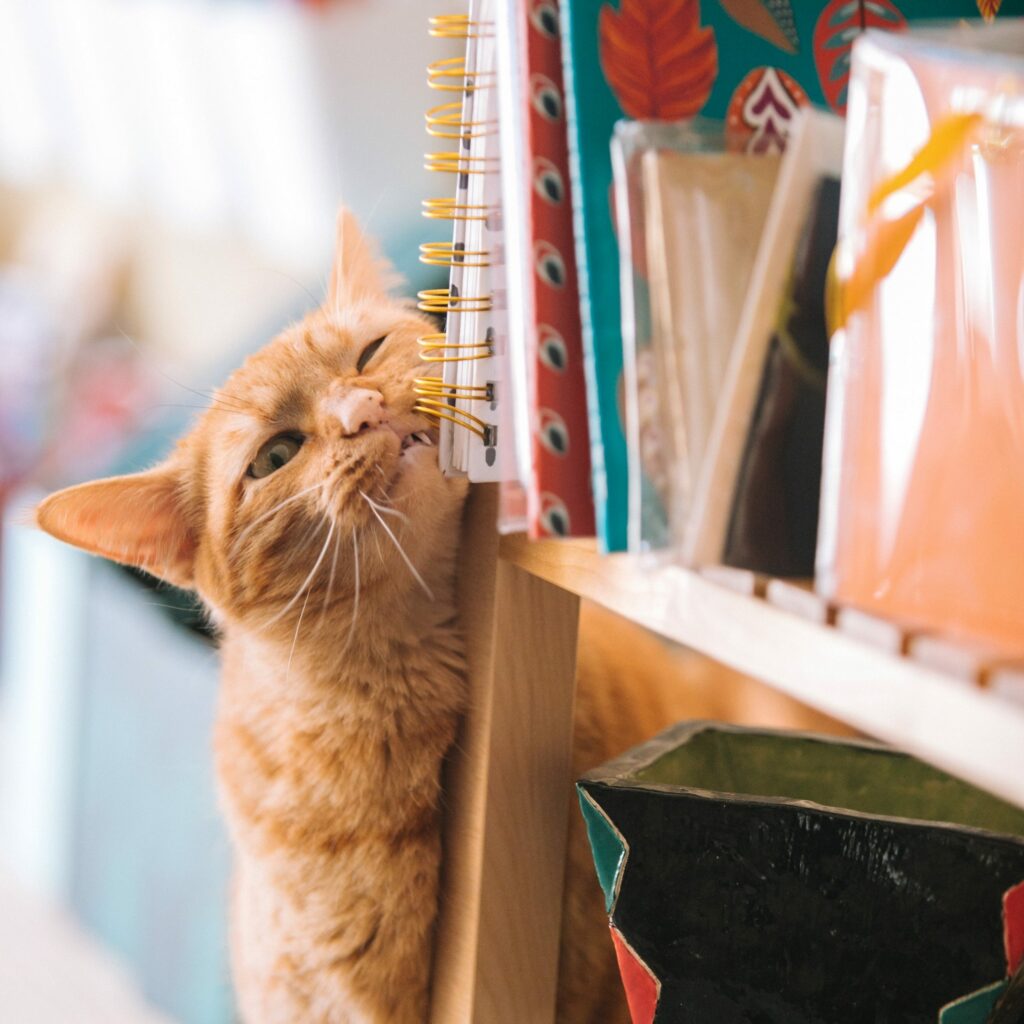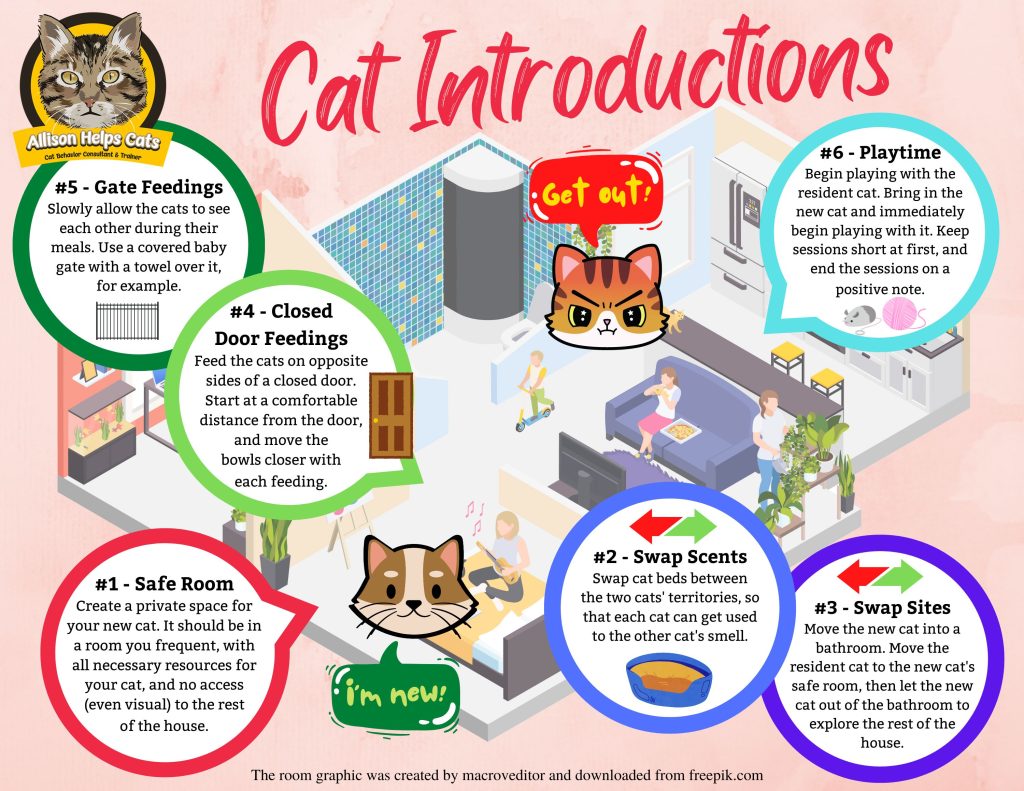Pets and Their People Blog
Cat Introductions – One Step at a Time
Since starting my cat behavior consulting business in 2019, the issue that I have been most often contacted about is that of cat introductions. While there are some cats that will roll out the welcome mat almost immediately for a newcomer, most need a more structured approach.
1. SAFE ROOM
The first introduction step is to start your new cat in a safe room. This room should have all the major resources that a cat needs: feeding station, litter box, scratching post, bedding, and toys. One benefit of a safe room is that it allows your new cat to gradually get used to your home. Another benefit is that it provides your new cat with a place to retreat while he’s still becoming comfortable in your home. You should allow your new cat at least a few days to acclimate to the room before doing introductions.

key resources to take on
a shared scent. (Photo by
Tucker Good on Unsplash )
2. SCENT EXCHANGE
Cats know each other best by scent, and so the second introduction step is a scent exchange, which will allow your cats to become comfortable with the smell of each other before they meet. Rub a clean sock on the face of your new cat to collect his pheromones, and then place it in your resident cat’s area. Because you don’t know how your resident cat will react to the scent of your new cat, don’t direct your resident cat to the sock, but instead simply allow her to discover it as part of her daily explorations. For the same reason, avoid placing the sock near where your resident cat eats, sleeps, or uses the bathroom. Follow the same procedure using the matching sock to collect facial pheromones from your resident cat and then to place in the newcomer’s room.
3. SITE SWAP
The third introduction step is site swapping, which will allow each cat to explore the other’s territory before they see one another, and to increase their exposure to each other’s scents. It’ll also provide an opportunity for key resources to take on a shared scent. Place your resident cat in a separate room and then open the door to the safe room so that your new cat can securely explore the rest of your home.
If you want to allow your resident cat the option of exploring the safe room, you’ll need to place the newcomer in a separate room before then opening the door of the safe room for your resident cat to explore. If possible, repeat this step at least once a day throughout the introduction process.
4. CLOSED DOORS
As important as creating a group scent, it’s also critical that you give the cats a reason to like one another. To do this, positive things need to happen when they’re close, and food is the best way. Feed the cats by placing food dishes on either side of the safe room door. Use treats rather than their regular meals to avoid creating a negative association with their food before the cats have become comfortable with each other. Also, do not do this within an hour of the next meal, as the cats may be more agitated at this time. Start with the dishes being placed six feet away and then moving the bowls incrementally closer only when the cats act comfortable with each other. Your goal is to move the bowls within three feet of the door.
5. VISUAL ACCESS
Once your cats are used to each other’s scent, it’s time to allow them to see each other. While the work that you’ve done up to this point should have resulted in predictable behavior between your cats, you still need to proceed with caution. Install a gate in the doorway of the safe room. Reposition their food dishes to six feet away from the gate and allow them visual access for about 10 seconds, then 20 seconds, and then 30 seconds. Now move the dishes to within five feet and repeat the whole 10-20-30 seconds of visual access, until the cats are within three feet.
How slowly should you take this fifth step? That will depend on how reactive your cats are. I’ve had cases where a towel needed to be placed over the gate and moved a few inches at a time because the cats were reacting negatively to each other even at a distance. The key is to observe the body language of your cats and to go at the pace of your least tolerant cat.
6. SUPERVISED INTERACTIONS
There’s just one final step, but it’s as important as the rest. When you finally allow the cats to be in the same room, they’ll need help figuring out how to co-exist in a shared space. Use parallel play as a way to allow them to see each other in their peripheral vision, and also to reinforce the idea that good things will happen when the other is around. Have a cat wand toy in each hand or enlist the help of a second person so that each cat won’t be vying for the same toy. As with the steps involving treats, start by keeping the interactive play sessions short and increase them only when their body language tells you that they’re okay with each other.
How slowly should you take this sixth and final step? Again, that will depend on your cats. I’ve had cases where one cat had a fearful personality and we first had to build her confidence with training. I’ve also had cases where the cats had mismatched play styles and we first had to provide additional enrichment for the more aggressive cat. Finally, I’ve even had cases where, after getting the cats comfortable with each other during play, we then had to gradually increase their comfort with each other during times of inactivity.

When introducing a new cat, it’s important to take it one step at a time, and even to backtrack if needed. If you’re uncertain of when to backtrack and when to proceed, you might hire a cat behavior consultant to walk you through the steps. Both cats have to be comfortable with the pace of their relationship because they are the ones who will have to share each other’s resources and live together within the confines of your house. Happy intros!

Allison Hunter-Frederick is a Cat Behavior Consultant, Trainer, and Educator. She is also the mother of three fur kids and several revolving foster cats, host mom to international students, and wife of a supportive husband. Through her business Allison Helps Cats LLC, she uses her knowledge of cats to help cat owners and animal shelters with their cat behavior needs. She is most often asked to help with cat re/introductions!

